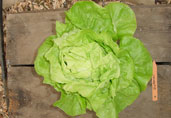
Plans to Expand, Using Guano Productively
Chuck and I had a brainstorming session the other day, trying to figure out how to expand our business. We’ve reached our goal of producing 400 heads of Boston lettuce a day, but given the size of our greenhouse, that is the maximum number we can produce.
I suggested branching out, building two more greenhouses, and growing spinach in one, and pak choi in the other. This would continue to follow the model set by the Cornell University Controlled Environment Agriculture experiment, that was the inspiration for our hydroponic lettuce-growing venture in the first place.
Chuck argued that Cornell tried growing spinach, but found it to be more of a difficult crop than lettuce. I countered that pak choi, on the other hand, was found to be an easy crop to grow.
Given the large ethnic Chinese population in a nearby city, pak choi would be a profitable vegetable, to be sure. But since Chuck is not as enthusiastic about Chinese food, as I am, our pak choi plans fell by the wayside.
“Why don’t we just build two more greenhouses and expand to grow different types of lettuce?” asked Chuck. It was a good question. Further market research is needed, before we can decide on such a major investment however.
Consumers are increasingly interested in healthier foods. A crisp, fresh salad has replaced the fatty lunches of the past. We are riding the crest of this new wave of wiser nutritional decisions. We need to do better than what we are able to today.
Just as our customers are keen to add better nutrients to their diet, Chuck and I are constantly thinking of how to improve the nutrient intake of our lettuce plants. We consult the Advanced Nutrient technical guys on a weekly basis, in order to ask their advice with regard to products that grab our attention, when we browse their Advancedepedia.
Grandma Enggy’s Fish Stew looked promising, but alas it’s been discontinued. Mother Earth Blended Super Tea Grow had a short write up last time I checked, then the other day I discovered that more information had been added, so the product description now totals 12 pages.
We’ve been using this product to add that organic touch to our basic synthetic ferts, Micro and Grow, since the Super Tea has alfalfa extract, canola meal, citric acid, crab meal, earthworm castings, fish meal, sea kelp, and shrimp meal in a blended, organic mix.
The new product description lists as additional ingredients: leonardite, sea weed meal, and two blends of guano. According to the write-up, “some of the richest bio-materials found on Earth” are included in Mother Earth Super Tea.
Guano, for the uninitiated, is excrement or manure. Both seabird guano and bat guano are included in the Super Tea mix.
Bats eat a lot of insects, so their guano contains chitin and has a higher percentage of nitrogen. I never heard of chitin, so I had to look that one up in the dictionary. Chitin is the principal constituent of the hard covering of insects and crustaceans. Sort of like grinding up sea shells to feed the powder to your plants.
Seabirds eat a lot of fish, so their guano contains copious amounts of phosphorus, as well as other biologically available nutrients that come from the sea.
We always knew that Mother Earth Super Tea Grow helped us grow better heads of lettuce, but little did we know why.
Further in our research, we found that triocontanol is a lipid in alfalfa meal that speeds up the metabolic rates of certain, membrane-bound enzymes. This process helps to increase photosynthesis in plants by a significant percentage.
Okay, so photosynthesis according to its abbreviated definition is the process by which plants turn light and CO2 into sugars and oxygen. These carbohydrates are the nutrients that cause a plant to grow.
Naturally, since we know that lettuce requires extra Calcium to be healthy, we apply Sensi Cal Grow regularly. In addition to calcium, this Advanced Nutrients product contains its sister element, Magnesium, as well as many other micro-nutrients necessary for optimum growth.
Compounds of Boron, Cobalt, Copper, Iron, Molybdenum, and Zinc complement the SensiCal Mg Mix Grow. We don’t use its other version, SensiCal Mg Mix Bloom, since we definitely do not want our lettuce plants to go into flower.
Chuck and I are still debating whether to proceed with producing more lettuce or to branch out into some other vegetable. The fact remains that with increased fuel costs, transporting fresh produce great distances to distant markets will become less and less economically feasible.
Hydroponic greenhouses, such as ours, located near the market they serve, are the way of the future.
posted by silvio @ 3:29 PM
0 comments
![]()

0 Comments:
Post a Comment
<< Home